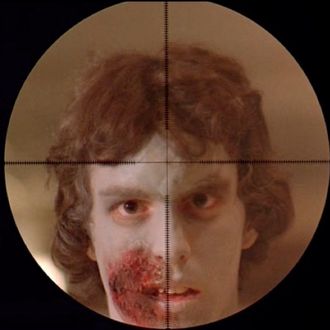
When George Romero’s Night of the Living Dead debuted in 1968, it changed horror forever. Using savage violence as social commentary, this tiny film reinvented the zombie genre and inspired a half a century of imitations, variations, and homages. Romero died Sunday, but his films make him immortal. To honor the master, here is a collection of some of his greatest hits, along with films that were either crucial inspirations to the horror legend, or films that were heavily inspired by him.
White Zombie (1932)
If you want to know just how much Romero changed the way we view zombie films, try watching this 1932 entry, directed by Victor Halperin and starring Bela Lugosi, which is considered the first feature-length zombie picture. Before Night of the Living Dead, zombies were typically living people transformed into monsters, instead of freshly dead bodies rising to walk again. White Zombie and films like it often centered on the barbarism of dark-skinned people and exotic, tropical environments, which played to the fears and paranoia of white American viewers. What Romero did was bring the concept home — suddenly the threat could be anyone. It moved the zombie film, and the horror film, into a more modern age.
The Thing From Another World (1951)
Romero described the sci-fi thriller — an adaptation of John W. Campbell Jr.’s novella Who Goes There? — as “the first movie that really scared me.” The concept of an invisible force transforming friends, neighbors, co-workers, and companions into vessels for a malevolent force is a foundational concept that Night of the Living Dead was built on. What better movie to watch when remembering one of our masters of horror than the first one to scare the hell out of him?
Othello (1951)
Othello and The Thing From Another World both came out in 1951, making it an extremely formative year for Romero. In an interview with the Telegraph, Romero explained that when he was making Night of the Living Dead he deliberately avoided drawing substantial influence from the mythology of previous zombie films, which primarily rooted the monsters in mysticism and voodoo lore. Instead, he says, he was heavily influenced by the art direction of one of his favorite films, Orson Welles’s Othello, which inspired the lighting and photography style used in Living Dead.
The Tales of Hoffman (1951)
Yet another entry from 1951, Hoffman is a film adaptation of Jacques Offenbach’s opera of the same name, and it was Romero’s favorite movie of all time. Yes, that’s right — George Romero was the father of zombies, a trailblazer of onscreen gore, and a lover of this fantastical screen opera about a poet looking back on three women he lost in his life. It’s good to have varied interests.
The Birds (1963)
Hitchcock’s classic is about a town overrun by malicious birds that descend on the citizenry in an organized, bloodthirsty swarm — stalking people, trapping them in their homes, pecking their eyes out, and overcoming their more intellectually advanced targets through relentlessness and sheer numbers. Sound familiar? Both The Birds and Night of the Living Dead are, at their core, narratives of invasion, and Romero owes at least a little of his zombie attack strategy to the drone armies of Hitchcock.
Night of the Living Dead (1968)
Night of the Living Dead was a landmark film that demonstrated the power of horror as a vehicle of social commentary. By removing the monsters from their voodoo origins and turning them into a local terror, it was also the beginning of the modern zombie film. As Romero said, “All I did was I took them out of ‘exotica’ and I made them the neighbors. I thought there’s nothing scarier than the neighbors!”
Martin (1977)
Martin focuses on a young man who’s become convinced he is a vampire, but because he lacks actual fangs, must use razor blades to draw blood from his victims. No one takes Martin’s bloodlust too seriously — besides his grandfather, the one person who suspects he has actually fallen under a vampire’s curse. This was Romero’s favorite of his films, and it also marks his first behind-the-scenes collaboration with special-effects artist Tom Savini, who would continue to work with the director on movies like Dawn of the Dead, Knightriders, Creepshow, and more.
Dawn of the Dead (1979)
Romero’s zombie follow-up to Living Dead was another home run, but for the sequel he moved the monstrous hordes from a rural farmhouse to the most capitalist of institutions: a shopping center that’s been overrun by the undead. The result is a tense zombie thrill from beginning to end, featuring fabulous gore brought to life by Savini. The director helmed six movies in his undead franchise, but the first two remain the best.
Knightriders (1981)
This is Romero’s second-favorite film of his films, and it has nothing to do with zombies. Instead, this drama stars Ed Harris as the leader of a group of bikers that don suits of armor and compete as jousters at Renaissance fairs. There are power struggles. There is battling through injury. It’s one hell of a passion project.
Creepshow (1982)
Romero was hugely influenced by comics from an early age, and his love for the medium persisted throughout his life. In particular, the director grew up reading stories from the publisher Entertainment Comics, popular for its fantastical narratives in the ’40s and ’50s. EC specialized in horror, crime, satire, and science fiction, and Creepshow was an anthology movie of vignettes based on those old EC tales. It was also Romero’s first screenplay collaboration with Stephen King.
Two Evil Eyes (1990)
Admittedly, this is not a great movie, but still, Romero teaming up with Dario Argento to direct a pair of short films based on the stories of Edgar Allan Poe is pretty impressive just for the mere fact of its existence. It’s like pulling a pair of legends out of a hat and assigning them to your English lit project — the idea is slightly more fun than the execution.
Bruiser (2000)
Romero made Bruiser — a revenge thriller about a soft-spined corporate lackey who goes on a killing spree after his face is replaced by a featureless white mask — after a frustrating seven-year absence from directing. As he explained to the A.V. Club, the long gap between films was the result of a housekeeping deal with New Line: “It was seven years or something out of our lives, and nobody made a movie. We made more money than we’d ever made, ever! But nobody was making any movies with us.” With American studios proving to be all talk and no action, Romero got himself working again by shooting Bruiser in Canada with help from a French financing company. Romero usually had access to studio support throughout much of his career, but he never shed his indie spirit, and always appreciated getting back to a stripped-down style of filmmaking.
Shaun of the Dead (2004)
Shaun was a tribute to and a send-up of the genre that Romero built, and the maestro loved the film. He described it as being “done with such affection” and counted its director, Edgar Wright, as a friend. Shaun is indeed a great comedy, and belongs in the undead film hall of fame, too. Romero also appreciated that the monsters were actual zombies — humans who rose up from the grave — instead of just sprinting drones who fell victim to some kind of contagion. (Looking at you, World War Z.)
Nightmares in Red, White and Blue (2009)
This documentary is a feature-film-length adaptation of the book of the same name, and it focuses on the relationship that horror films have to current events, how they explore and exploit the societal fears and anxieties of the moments in which they are made. Romero, who made movies about the collapse of civilization that commented on issues like racism and consumerism, is interviewed in the doc, along with his fellow horror master John Carpenter.
The Crazies (2010)
The original Crazies from 1973 was Romero’s third feature. It’s not his best work, but the remake from 2010 is surprisingly good. Romero executive-produced the movie, in which the unassuming town of Ogden Marsh starts falling apart when its inhabitants begin to go mad, killing their own families and burning down their own houses. It’s a welcome adjacent addition to the Romero canon.
Birth of the Living Dead (2013)
If you’re a Romero-phile or you just want to learn about how a little guerrilla-style indie film came together on a shoestring budget before it went on to change the world of film, this making-of documentary is just what you need.
Get Out (2017)
Jordan Peele has been very clear about how heavily Night of the Living Dead influenced him as a film fan and a filmmaker, citing the movie as one of his biggest inspirations for Get Out. Living Dead’s Duane Jones was a groundbreaking figure, a black horror hero who was capable, strong, and in charge. He almost survived the uprising of the undead, but (spoiler alert) was killed at the very end of the film after being mistaken for a zombie. Fifty years later, Peele’s hero in Get Out almost suffered a similar fate.


